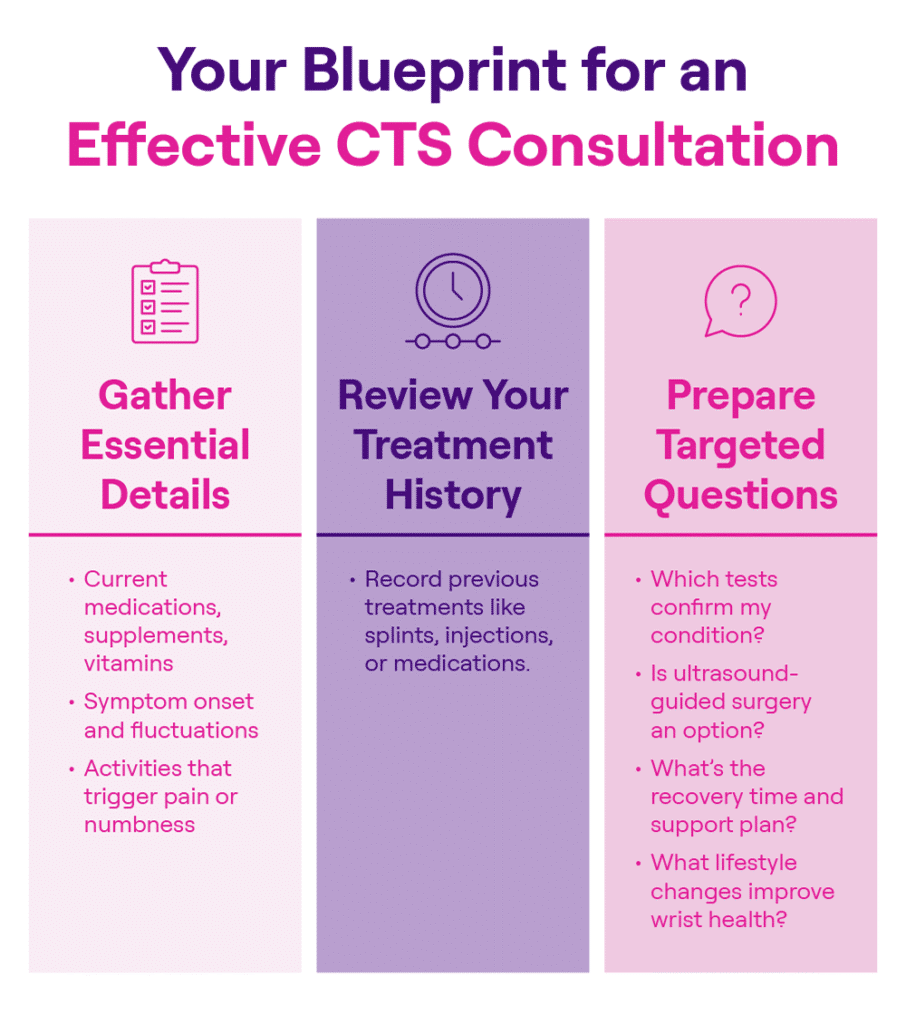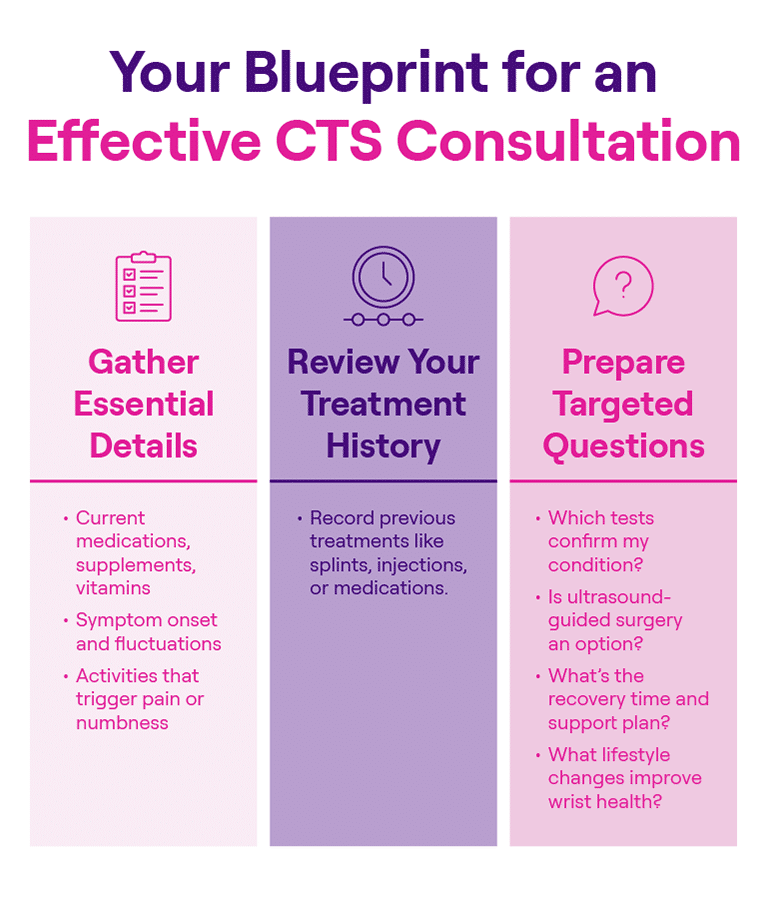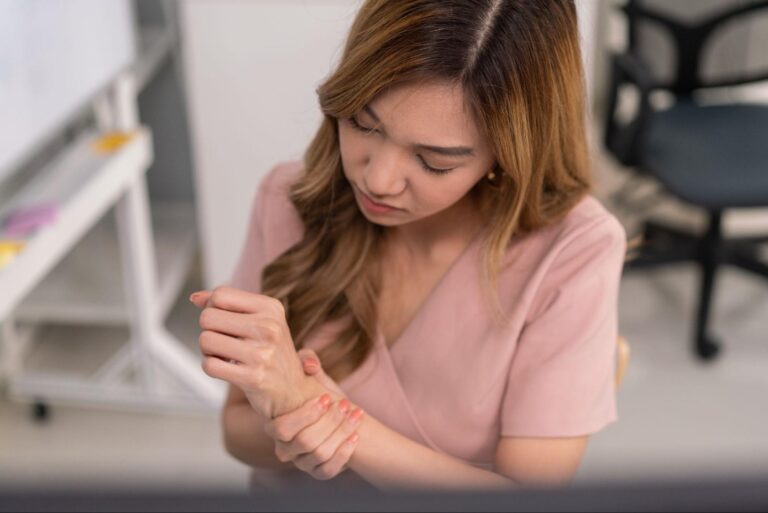Carpal tunnel syndrome (CTS) may disrupt everyday life with persistent numbness, tingling, or pain in the hand and wrist. These symptoms can make tasks like typing or holding a cup challenging and may even interrupt sleep. While non-invasive measures such as wrist splints and physical therapy may help some individuals, others require more focused intervention to address pressure on the median nerve. Choosing the right physician becomes a vital step in receiving effective care for CTS.
A specialist experienced in diagnosing and treating CTS—and particularly one who performs carpal tunnel release with ultrasound guidance (CTR-US)*, a technique that uses real-time ultrasound imaging to guide the release—may offer a patient-friendly path toward relief. This guide outlines the key qualifications to look for, explains the benefits of diagnostic ultrasound, and describes why minimally invasive treatment methods may help individuals enjoy a faster recovery.1-3
See below for CTR-US indication and link to important safety information.
Understanding Carpal Tunnel Syndrome and Its Treatment Options
CTS occurs when the median nerve is compressed within the narrow passage in the wrist formed by bones and ligaments. When pressure builds up in the carpal tunnel, the median nerve may become compressed, causing discomfort. The condition is often the result of repetitive motion or a medical condition such as diabetes or arthritis. Certain characteristics, such as gender, age, and family history, may also predispose individuals to develop CTS.
Signs and Symptoms
Common CTS indicators include:
- Pain or tingling in the hand, wrist, or forearm (often noticeable during repetitive tasks)
- Numbness in the thumb, index, middle, and part of the ring finger
- A weakened grip that may result in dropping objects
- Nighttime discomfort affecting sleep quality
Left unmanaged, CTS can lead to persistent numbness, weakness at the base of the thumb, and reduced hand function.
Treatment Options
Treatment options may vary according to the severity of symptoms. Many patients begin with conservative measures in an attempt to help alleviate discomfort, such as:
- Wrist splints: Maintaining a neutral wrist position, especially at night.
- Anti-inflammatory medications: Over-the-counter remedies (like ibuprofen) may help reduce inflammation.
- Corticosteroid injections: These temporarily reduce swelling in the carpal tunnel. For more information, see this clinical study on corticosteroid injections.
- Physical therapy: Stretching and strengthening exercises can help improve wrist flexibility and function.
- Lifestyle modifications: Adjusting activities or work habits to reduce pressure on the wrist.
If these approaches do not bring relief, a carpal tunnel release (CTR) procedure may be recommended. Traditional carpal tunnel release involves making an incision to address the transverse carpal ligament, relieving pressure on the median nerve. While effective, it often comes with a longer recovery period and a larger incision. By contrast, carpal tunnel release with ultrasound guidance (CTR-US) utilizes real-time ultrasound imaging, which may lead to less tissue disruption, a smaller incision, and a quicker return to daily activities.1-4 This technique is typically performed in an office-based setting under local anesthetic.1-5 Please discuss the risks and benefits of this procedure with your healthcare provider.
Take A Symptom Survey
Key Qualifications and Experience to Look for in an Physician for CTS
Deciding on the best physician for CTS requires careful consideration. Look for a specialist who possesses the following qualifications:
Specialization in Hand and Wrist Conditions
Physicians who concentrate on hand and wrist disorders often complete advanced training in:
- Recognizing and differentiating CTS from similar conditions
- Understanding the anatomy of the hand, wrist, and forearm
- Offering a comprehensive range of treatments, from conservative management to minimally invasive interventions
Advanced Training and Certifications
Look for specialists who are skilled in subspecialties or fellowships related to hand and wrist care.
Direct Experience with Minimally Invasive Techniques
When contemplating a technique such as CTR-US, inquire about:
- The frequency with which the physician performs carpal tunnel release with ultrasound guidance
- The typical outcomes observed among those who choose this approach
Physicians, even early in their training, are able to offer patients this technique that translates to minimal downtime and a more comfortable recovery because of the added safety of ultrasound guidance.6
Proven Track Record and Patient-Centered Care
Look for positive signs of patient-centered care, such as:
- Patient testimonials reflecting successful outcomes or compassionate physician support
- Recommendations from trusted medical professionals
- Transparent data regarding treatment success rates and low complication numbers
These indicators often point to a specialist who emphasizes personalized care for every individual.
The Advantages of Minimally Invasive Treatment for CTS
Carpal tunnel release with ultrasound guidance (CTR-US) offers several advantages over traditional carpal tunnel release:1-5
Minimally Invasive Technique
CTR-US involves a smaller incision and typically causes less tissue disruption than traditional CTR. This feature may contribute to a more comfortable recovery and a shorter downtime.1-4
Real-Time Imaging Benefits
Real-time imaging helps the physician visualize the carpal tunnel region and the median nerve during the procedure. This capability may help avoid potential damage to surrounding tissues, which may lead to a more comfortable recovery and a faster return to daily activities.1-3
Local Anesthesia
Local anesthetic blocks nerve impulses, providing a pain-free procedure. This approach also eliminates the risks associated with general anesthesia.1-3,5
Clinic or Office-Based Treatments
Since CTR-US is generally performed in a clinic or office-based environment under local anesthesia, you avoid extended hospital stays.3,5 This arrangement tends to streamline care, allowing many individuals to experience a notably quicker return to daily tasks.1-4
While results vary among patients, these benefits suggest why minimally invasive approaches remain a popular choice.
Please speak with your healthcare professional about the risks and benefits of this procedure.
The Role of Diagnostic Ultrasound in CTS Evaluation and Care

Diagnostic ultrasound helps confirm carpal tunnel syndrome and plan the proper course of action. By producing live images, ultrasound allows immediate assessment of the median nerve’s condition.
How Diagnostic Ultrasound Works
A handheld probe sends sound waves into the wrist, generating continuous images on a screen. The doctor can view structures such as the median nerve in real time. This capability supports:
- Accurate evaluation of swelling or abnormalities
- Clear identification of anatomical features during carpal tunnel release with ultrasound guidance
Beyond its imaging benefits, diagnostic ultrasound is efficient, painless for most patients, and patient-friendly since the images appear instantly.7 It can be quicker and more cost effective than many other imaging methods. Unlike some diagnostic tests that require sample processing or external analysis, ultrasound provides immediate feedback with minimal discomfort, helping patients feel more at ease.7
Additionally, research such as high-resolution ultrasound studies has revealed that subtle changes in the wrist can be detected early, offering more detailed insights during CTS diagnosis.
How to Evaluate and Choose the Best CTS Specialist or Clinic
When selecting a specialist for carpal tunnel syndrome, weigh these considerations:
Access to Vital Diagnostic Resources
Clinics that offer high-quality ultrasound and other imaging tools can tailor diagnostic and treatment plans more effectively. Such resources equip providers to pinpoint and address any structural concerns early.
Office-Based CTR-US Availability
Ask whether the center performs CTR-US in a comfortable, clinic-based setting. Confirm:
- The presence of necessary ultrasound technology on-site
- The availability of staff trained to optimize patient comfort
- Protocols ensuring a smooth experience from check-in to post-procedure follow-up
Commitment to Personalized Plans
A dedicated CTS specialist typically:
- Adapts treatment goals to specific symptoms and lifestyles
- Provides realistic time frames for recovery
- Offers clear instructions for post-procedure care
By creating a customized plan, the physician respects individual needs, whether you have a desk job or a physically demanding occupation.
Reputation and Patient Feedback
Look at available resources for testimonials or doctor reviews. Positive ratings often highlight qualities such as:
- Effective communication and respect for patient concerns
- Thorough explanations of procedures, recovery steps, and potential outcomes
- An atmosphere of empathy and personalized attention
Long-Term Extensive Care
Some providers guide you through every phase of recovery, which can include:
- Follow-up visits to track healing
- Physical therapy for regaining strength and flexibility
- Ergonomic guidance to reduce strain on healing tissues
This continuous support helps maximize lasting hand health.
Preparing for Your Consultation with a Physician


Before your initial consultation, you can take some steps to help make the most of your time with the physician. First, gather relevant information:
- List current medications, including supplements and vitamins.
- Track when your carpal tunnel syndrome symptoms started and how they fluctuate.
- Note specific activities that worsen numbness, tingling, or pain.
- List prior medications, splinting methods, or injections you have tried.
- Compile questions for your specialist, such as:
- Which diagnostic tools will confirm my CTS?
- Would carpal tunnel release with ultrasound guidance (CTR-US) potentially fit my situation?
- How long is the typical recovery, and what support will I receive post-treatment?
- What lifestyle adaptations can promote long-term wrist health?
This approach may help create a more informed discussion and a customized plan suited to your individual circumstances.
Long-Term Recovery and Preventative Strategies
Long-term management of CTS goes beyond addressing immediate discomfort. To help sustain improvements:
- Schedule routine follow-ups to monitor any recurrence.
- Engage in exercises that target the wrist, including gentle stretches and strengthening maneuvers.
- Incorporate ergonomic adjustments in your workplace—ergonomic keyboards and properly positioned monitors can lessen strain on the wrists.
- Practice healthy lifestyle habits by maintaining hydration, balanced nutrition, and stress management techniques.
By keeping aware of future risks, you can help prevent a return of CTS symptoms or at least intercept them early if they do recur.
Stress Management and Home Exercises
Managing stress can be an important yet often overlooked element of CTS care. Raised tension levels may encourage muscle tightness in the shoulders, neck, and forearms, indirectly affecting wrist comfort. Taking time to relax the upper body can ease strain on the median nerve in the wrist. Techniques like deep breathing, meditation, or gentle yoga movements may benefit both mental and physical well-being.
Alongside stress relief techniques, home-based exercises may help maintain better hand function. Gentle wrist stretches that involve flexing and extending the fingers, or moving the wrist from side to side, can keep the area flexible. These exercises may be performed a few times a day, especially during work breaks. The American Academy of Orthopaedic Surgeons recommends simple hand and wrist exercises that could complement your treatment plan. Consistency in these practices may strengthen muscles and tendons around the carpal tunnel, helping to sustain or improve comfort during recovery.
Daily Lifestyle and Ergonomic Practices for CTS Management
To help prevent or manage CTS symptoms, consider incorporating the following practices into your daily routine:
- Optimizing your workstation: Adjust chair height, desk arrangement, and keyboard alignment for neutral wrist posture.
- Using specialized accessories: Wrist-supportive devices can reduce strain during repetitive tasks.
- Taking frequent breaks: Pausing regularly for a few wrist stretches adds up to better comfort.
- Maintaining strength and flexibility: A daily habit of hand and wrist exercises supports overall nerve health.
- Maintaining a healthy weight: Excessive body weight can contribute to pressure on the carpal tunnel, so staying within a healthy range may mitigate discomfort.
- Staying active: Regular exercise helps maintain overall health and may reduce inflammation that could potentially contribute to CTS.
These practices may also complement treatments such as CTR-US and help you maintain long-lasting hand and wrist health.
Emerging Trends in CTS Management
As technology evolves and research deepens, many exciting trends have emerged in CTS management. Some of the most notable include:
- Advanced Ultrasound Techniques: High-resolution and contrast-enhanced ultrasound offer a clearer view of the carpal tunnel, increasing the likelihood of accurate diagnoses.
- Minimally Invasive Techniques: Techniques such as carpal tunnel release with ultrasound guidance are increasingly replacing traditional open surgery.
- Telemedicine: Remote consultations and follow-up sessions help physicians monitor symptoms and provide timely advice without requiring extra travel.
- Portable Ultrasound Devices: These smaller devices make imaging more accessible, allowing specialists to identify and address potential issues effectively—even in settings that previously lacked advanced imaging tools.
Such trends underscore the ongoing improvements in accessibility and individualized care for CTS.
Find A Physician Near You
Empower Yourself with the Right Specialist
Managing CTS does not need to be overwhelming. By selecting a physician well-versed in hand and wrist disorders—and who regularly utilizes carpal tunnel release with ultrasound guidance (CTR-US)—you establish a strong platform for care. Real-time imaging through diagnostic ultrasound can expedite accurate diagnosis and guide a course of action that respects your comfort and time.
Alongside other therapies, such as ergonomic modifications and home exercises, CTS specialists can help you maintain a healthy and functional wrist for the long term. By making informed choices and implementing a comprehensive management strategy, you can help ensure that CTS does not disrupt your life in any significant way.
MP04202rA




